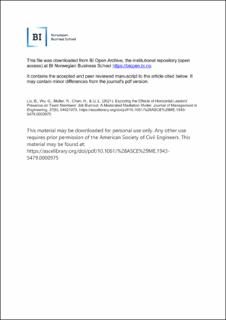| dc.contributor.author | Liu, Bingsheng | |
| dc.contributor.author | Wu, Guobin | |
| dc.contributor.author | Müller, Ralf Josef | |
| dc.contributor.author | Chen, Haitao | |
| dc.contributor.author | Li, Ling | |
| dc.date.accessioned | 2022-03-07T13:30:52Z | |
| dc.date.available | 2022-03-07T13:30:52Z | |
| dc.date.created | 2021-09-15T07:49:18Z | |
| dc.date.issued | 2021 | |
| dc.identifier.citation | Journal of Management in Engineering. 2021, 37 (6), 1-12. 04021073 | en_US |
| dc.identifier.issn | 0742-597X | |
| dc.identifier.uri | https://hdl.handle.net/11250/2983466 | |
| dc.description.abstract | This research aims to link leadership and employees’ well-being in the architecture, engineering, and construction (A/E/C) industry while focusing on horizontal leadership, which is displayed by subordinates, and job burnout among remaining team members. Based on social information processing theory and conservation of resource theory, we propose a moderated mediation model. We hypothesize that the presence of a horizontal leader (HL) in A/E/C project teams is related to remaining team members’ job burnout, which is mediated by perceived career opportunity (PCO). However, the relationship between HL’s presence and PCO changes from significantly positive among project team members with relatively low status conflict to significantly negative among team members with relatively high status conflict. The relationship between HL’s presence and job burnout is also reversed. The results of a scenario study (Study 1) using Masters of Engineering Management candidates as the sample (N=150) and a field survey (Study 2) involving 313 real team members support our hypotheses. Theoretical and practical implications of these findings are discussed. | en_US |
| dc.language.iso | eng | en_US |
| dc.publisher | ASCE Library | en_US |
| dc.title | Exploring the Effects of Horizontal Leaders’ Presence on Team Members’ Job Burnout: A Moderated Mediation Model | en_US |
| dc.type | Peer reviewed | en_US |
| dc.type | Journal article | en_US |
| dc.description.version | acceptedVersion | en_US |
| dc.rights.holder | ASCE Library | en_US |
| dc.source.pagenumber | 1-12 | en_US |
| dc.source.volume | 37 | en_US |
| dc.source.journal | Journal of Management in Engineering | en_US |
| dc.source.issue | 6 | en_US |
| dc.identifier.doi | 10.1061/(ASCE)ME.1943-5479.0000975 | |
| dc.identifier.cristin | 1934365 | |
| dc.source.articlenumber | 04021073 | en_US |
| cristin.ispublished | true | |
| cristin.fulltext | preprint | |
| cristin.fulltext | postprint | |
| cristin.qualitycode | 2 | |
